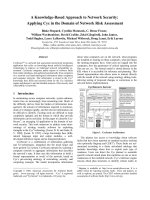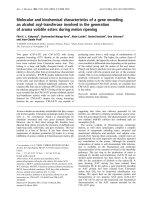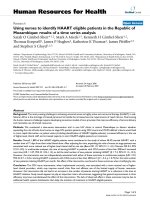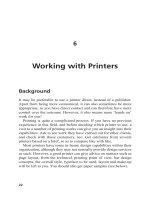A Knowledge-Based Approach to Network Security: Applying Cyc in the Domain of Network Risk Assessment pptx
Bạn đang xem bản rút gọn của tài liệu. Xem và tải ngay bản đầy đủ của tài liệu tại đây (293.66 KB, 6 trang )
A Knowledge-Based Approach to Network Security:
Applying Cyc in the Domain of Network Risk Assessment
Blake Shepard, Cynthia Matuszek, C. Bruce Fraser,
William Wechtenhiser, David Crabbe, Zelal Güngördü, John Jantos,
Todd Hughes, Larry Lefkowitz, Michael Witbrock, Doug Lenat, Erik Larson
Cycorp, Inc., 3721 Executive Center Drive, Suite 100, Austin, TX 78731
{blake, cynthia, dcrabbe, zelal, jantos, larry, witbrock, lenat}@cyc.com
, , ,
Abstract
CycSecure
TM
is a network risk assessment and network monitoring
application that relies on knowledge-based artificial intelligence
technologies to improve on traditional network vulnerability as-
sessment. CycSecure integrates public reports of software faults
from online databases, data gathered automatically from computers
on a network and hand-ontologized information about computers
and computer networks. This information is stored in the Cyc
®
knowledge base (KB) and reasoned about by the Cyc inference
engine and planner to provide detailed analyses of the security (and
vulnerability) of networks.
1 Introduction
In maintaining secure computer networks, system adminis-
trators face an increasingly time-consuming task. Much of
the difficulty derives from the burden of information man-
agement: the amount of information required is enormous,
much of it changes rapidly, and the relevant information can
be difficult to identify. Existing tools are difficult to keep
completely updated, and the format in which they provide
information can be unwieldy. In this paper we describe Cyc-
Secure
, an emerging AI application in the domain of net-
work security. This work endeavors to address some short-
comings of existing security software by exploiting
strengths in the Cyc
®
technology [Lenat, D. B. and Guha, R.
V. 1990], [Lenat, D. 1995]: a large knowledge base (KB),
natural language input and output modules, a well-
developed inference engine and an integrated planner.
CycSecure is a combination of information gathering
and AI technologies, integrated into the much larger and
more general Cyc system. CycSecure operates by scanning a
computer network to aggregate information that describes
the network’s state. It then uses this information to build a
formal representation or model of the network, based on
Cyc’s pre-existing ontology of networking, security, and
computing concepts. The model incorporates information
Copyright © 2005, American Association for Artificial Intelli-
gence (www.aaai.org). All rights reserved. “Cyc” is registered
trademark, and “CycSecure” is a trademark, of Cycorp, Inc.
about what computers are on the network, what programs
are installed or running on those computers, what privileges
the running programs have, what users are logged into the
computers, how the parameters of critical operating system
files are set, etc. The formal model is stored directly in the
KB, where it is accessible for inference and planning. This
formal representation also allows users to interact directly
with the model of the network using ontology editing tools,
allowing testing of proposed changes or corrections to the
network before implementation.
CycSecure Server
CycSecure
Sentinels
Network
Model
Stored in
Cyc KB
Cyc’s
Computing
Domain
Knowledge
Cyc Inference Engine & HTN Planner
Query
Tool
Network
Viewer
Network
Statistics
Tool
Model
Editor
Attack
Plan
Analyzer
Dynamic HTML User Interfaces
Common
Sense
Knowledge
In Cyc KB
CERT
Bug-
Traq
Outputs
Natural language
(NL) descriptions of
network attack plans
NL descriptions of
network remedy
steps
Detailed, editable
and web-browsable
network model
NL answers to nearly
arbitrary NL queries
about the model
The planner has access to knowledge about software
faults that have been reported on standard security tracking
sites (primarily Bugtraq and CERT
1
). These faults are tax-
onomized according to a finely articulated ontology that
includes knowledge about how to exploit each type of
weakness. Users can direct the Cyc planner to assemble
specific network attack plans that capitalize on one or more
weaknesses in the modeled network. Cyc’s inference engine
reasons about plan structures to identify critical nodes in
1
Bugtraq is available at: . It is a
public forum for reporting security faults. Fixes and patches, as
well as exploits, are posted. The CERT website provides detailed
assessments of software faults: .
Figure 1. CycSecure Architecture
attack plans to propose single-step remedies (e.g., recom-
mending downloading software patches to fix critical faults,
or recommending specific alternative programs with the
same functionality).
2 Application Description
2.1 Cyc Technology Overview
Cyc is composed of a large KB, an inference engine, a plan-
ner and natural language components.
• The KB: common-sense knowledge encoded in the CycL
language. Approximately (as of March 2005) three mil-
lion assertions (facts and rules) interrelating over a quar-
ter of a million concepts.
• The inference engine: a resolution-based reasoning sys-
tem, consisting of a general theorem-prover and a grow-
ing regiment of over eight hundred special-purpose mod-
ules. Each module is an implementation of a pattern of
reasoning for a common type of problem.
• The planner: an extension of SHOP [Nau et al. 1999],
which is an efficient hierarchical task network planner.
• NL parsing and generation components: a general lexi-
con, parsing, generation and discourse modules. NL gen-
eration underpins all CycSecure interfaces.
The common-sense knowledge in the KB consists, in part,
of categorizations of objects and general truths about types
of objects. Having this pre-existing framework simplifies
encoding domain-specific knowledge, such as that required
for CycSecure. CycSecure’s knowledge focuses on topics
such as computer programs and their functionalities, com-
puter network vulnerabilities and network attack plan ac-
tions. The representations of these classes was facilitated by
the existing representations of more “common-sense” con-
cepts: types of information-bearing things, such as prose
text, emails, computer viruses, applications and operating
systems; concepts of information flow and information
transfer; and even the basic concept of a computer, as a
temporal, tangible thing. It was also useful to draw on the
pre-existing representations of human agents as having mo-
tives, drives and behavior patterns, many of which are rele-
vant to the way networks are used and thus affect security.
Given the broad range of existing ontological distinc-
tions in the KB, it was clear how to incorporate the requisite
new classes of security domain knowledge. A team of just
3-4 trained knowledge enterers was able to add all relevant
knowledge to the Cyc KB in under 18 month’s time. This
rapidity was facilitated by the ability to forgo spending time
stating relevant general facts, such as the fact that an elec-
tronic device that is turned on will stay turned on until its
power supply is interrupted.
2.2 CycSecure Architecture Overview
The architecture of the CycSecure system is centered on a
CycSecure server. The server in turn rests on a Cyc image,
which includes the components described above, as well as
a set of interfaces that allow users to interact with network
models. The interfaces include an editor, a network statistics
reporter, a viewer (for browsing information about different
parts of the network) and an interface to the planner. The
CycSecure server is designed to run on a dedicated machine.
It handles all user interaction and KB interaction tasks.
Each client machine on the network runs a daemon (or
Sentinel) that gathers information about the software, hard-
ware and status of the machine it is running on. The server
polls the Sentinels, gathers network information from them,
and then represents that information in the KB.
2.3 CycSecure Software Components
CycSecure Sentinels and Server
The Sentinels are small software daemons that run on each
machine on the target network. They are designed to con-
sume very few system resources; such remote agents can be
installed on even slow machines on a network without in-
curring a serious performance cost [Humphries, J. W. and
Carver, C. A. Jr. 2000]. Each Sentinel is dormant until
polled by the server. When polled, a Sentinel gathers infor-
mation about the machine it is running on and relays it to
the server. Sentinels are extremely platform dependent, but
they share a common XML protocol understood by the
server; as a result, they can be written for multiple plat-
forms, potentially including dedicated firewall hardware or
smart hubs.
2
The server translates the information returned
by the Sentinels into CycL and adds it to the KB.
This approach is potentially vulnerable to an attack on
the Sentinels themselves, or to spoofing of their communi-
cation. The latter concern can be addressed by encrypting
the communication stream. However, since each Sentinel is
sending unique information about the machine on which it
is installed, the former concern is very real. Installing each
Sentinel with a communications wrapper that contains a
rolling key helps somewhat, but is still subject to some
kinds of attacks and increases the complexity of upgrading
the Sentinels over time.
CycSecure’s architecture is not dependent on using Sen-
tinels. It could also utilize third-party daemons that may
have already solved some of these problems.
CycSecure User Interfaces
Users access the CycSecure server via several interfaces: the
Attack Planner, the Model Editor, the Network Viewer, the
Query Tool and the Network Statistics tool. Each of these
tools is presented to the user in a web-browsing framework:
the CycSecure server dynamically generates HTML and
JavaScript in response to user interactions.
2
To date, Sentinels have been developed for Windows
95/98/NT/2000/XP, Linux RedHat and Solaris.
The Attack Planner enables the user to state plan goals,
launch the planner and view the attack plans generated. For
example, a user can state the goal “An external user with no
initial access gains administrator/root access to tar-
get.mynetwork.net.” The user then examines the plans re-
turned, using the browser to get more detail about any inter-
esting or unclear steps or components. (We discuss the At-
tack Planner in more detail in section 3.2, below.)
The Model Editor lets users edit the automatically built
network model (e.g., to add or remove machines or running
programs from the model). CycSecure performs analysis
against the model, so this tool lets users evaluate results of
changes before deploying them to the actual network.
The Network Viewer allows users to examine and drill
into the network model. For example, a user can view a
computer and see: hardware specifications for that com-
puter; programs running on it; information about a program,
which may include links leading to known faults; informa-
tion about exploits which can then be followed to a defini-
tion of buffer overflow exploits in general, etc.
The Query Tool allows users to construct queries over
predefined elements of the represented network and back-
ground knowledge such as installed programs, running pro-
grams, operating systems and IP addresses. The query is
passed to the inference engine, which returns lists of results.
The Network Statistics tool provides a synopsis of the
network state. It lists the number of machines on the net-
work, the number of vulnerabilities on the machines, etc.
This view of the network’s security state is useful for ob-
serving general patterns, but it does not indicate how any of
the vulnerabilities may be exploited to compromise network
resources. The Attack Planner imparts that more sophisti-
cated capacity (see section 3.2, below).
3 The Ontology and The Planner
3.1 Ontology
The general knowledge already represented in the KB facili-
tates deep reasoning about security: it includes knowledge
of communication protocols, computers, networks, firewall
rules, corporate policies, employee/employer relationships
and date and time functions, all of which are relevant to
interesting questions pertaining to security.
Cyc’s KB underpins all of CycSecure’s capabilities.
Some of the most pertinent portions are the ontology of pro-
gram types and their functionalities and the ontology of
software faults and their corresponding vulnerabilities.
There are currently 12,409 computer programs repre-
sented in the Cyc KB. At the top of this hierarchy stands the
collection
ComputerProgram-CW,
3
which is partitioned
into
ApplicationProgram and OperatingSystem. Im-
portant facetings of
ComputerProgram-CW are Com-
puterProgramTypeByPlatform
and ComputerPro-
gramTypeByFunction
. The latter faceting has 389 in-
stances and includes collections such as
Screensaver,
EmailClientProgram, NameServerProgram and Log-
inProgram
. This functionality-based faceting helps Cyc-
Secure present information in a structured (and therefore
easily comprehensible) manner. E.g., users can select a view
of computer that shows a list of its installed programs or-
ganized into a hierarchy of program types. Without a princi-
pled organization this list would be too verbose to be useful.
The hierarchy of program types is also used in vulner-
ability assessment and planning, since the same kind of
software fault can lead to different vulnerabilities, depend-
ing on what kind of program has the fault. Security faults in
software (as well as parameter misconfigurations) underpin
vulnerabilities of physical systems; an email program with a
buffer overflow fault yields a vulnerability that is function-
ally distinct from that of a printer driver with a buffer over-
flow fault. The planner takes these distinctions into account
when generating attack plans, which are multi-step ways of
capitalizing on vulnerabilities to achieve goals.
CycSecure’s ontologies of faults and vulnerabilities are
novel because they are integrated into a much larger general
ontology and are closely tied to planner rules. In the latter
sense, the existing work most similar to CycSecure’s fault
and vulnerability ontologies is that of Undercoffer and
Pinkston [2002]. Their ontology of attacks is “target-
centric,” emphasizing the means, consequences and loca-
tions of attacks as attack-type discriminators. CycSecure’s
ontology of faults and vulnerabilities is likewise target-
centric, in the sense that it has been built with the intention
of supporting the generation of attack plans. An important
3
The “CW” in the name of this collection indicates it is a speciali-
zation of ConceptualWork, the collection of deliberately cre-
ated things that lack a location in space but have a beginning in
time and an associated abstract information structure.
Figure 2. The Network Viewer Tool
In this screenshot, the tool displays NL descriptions
of deduced vulnerabilities of a computer in the model;
an explanation for one deduction is expanded into the view
.
distinction between CycSecure’s ontology and that of Un-
dercoffer and Pinkston is that the first is intended to support
vulnerability analysis, whereas the second offers an ontol-
ogy of attack types in support of intrusion detection.
Currently 354 classes of software fault are represented in
the Cyc KB. At the top of the relevant multiple-inheritance
hierarchy is the general collection,
ProgramFault, which
has eighteen direct specializations such as the collection of
denial of service faults, the collection of readable mail faults
and the collection of input validation faults
. Many faults in
the hierarchy are direct specializations of multiple other
faults. For example,
MountRequestForwardingFault is
a direct specialization of both
InsecureFilesystem-
Fault
and CommandFilteringBypassFault.
4
If a mount
request is for a filesystem that is mountable, a valid filehan-
dle will be returned. This filehandle in turn can be used to
access a filesystem that would otherwise not be accessible to
a remote user. Because an unauthorized mount request
should have been blocked,
MountRequestForwarding-
Fault is a specialization of CommandFilteringBypass-
Fault
, which is the collection of faults had by programs
that fail to reject certain requests. A
MountRequestFor-
wardingFault
can be exploited to gain unauthorized ac-
cess to a file system, so it is a specialization of
Insecure-
FilesystemFault
, the collection of faults had by pro-
grams that can be made to yield a copy of a filesystem to an
unauthorized user.
There are 683 classes of vulnerability represented in the
KB. The most general is
ComputerVulnerability, which
has 28 direct specializations, including the collection of
vulnerabilities to bounce attacks and the collection of vul-
nerabilities due to insecure login systems. A significant
faceting of the specializations of
ComputerVulnerabil-
ity distinguishes remotely exploitable vulnerabilities from
locally exploitable ones. To generate a complete plan in
which a hypothetical attacker exploits a merely locally ex-
ploitable vulnerability, the planner must incorporate prior
steps that grant the attacker local access.
3.2 Planner
Cyc’s planner is a variant of SHOP, an efficient hierarchical
task network planner [Nau et al. 1999]. The planning do-
main is a representation of actions that could be performed
using a computer system, especially those that could be per-
formed by malicious hackers or disgruntled employees. Ac-
tions are represented as CycL formulæ with instances of
ActionPredicate as their operators. For example,
(runProgramOnAs
NetworkUser033 Workstation010
(SoftwareVersionFn Mozilla 1.4)
(UserAccountFn LocalWindowsLAN "33"))
4
A program has a MountRequestForwardingFault if an unau-
thorized remote user can send a mount request to it that will then
be forwarded to the mount daemon.
means that NetworkUser033 is running Mozilla 1.4, on
workstation 10, with the privileges of the account with the
unique identifier “33,” on the local Windows network.
ActionPredicate is partitioned into ComplexAc-
tionPredicate
and SimpleActionPredicate. Com-
plex actions are tasks that can be decomposed into se-
quences composed of other complex actions or simple ac-
tions. Complex actions have preconditions and decomposi-
tions, and simple actions have preconditions and effects.
Users initiate planning by giving the planner a complex
action sentence as a goal (Figure 3). For example, the goal
(doGetLoginInfoForAccount Hacker ?ACCT) would
cause the planner to find all sequences of actions that result
in
Hacker acquiring login information for any account. The
predicate
doGetLoginInfoForAccount itself decom-
poses into a sequence of actions, one or more of which may
also be complex. Ultimately a plan will be returned only if,
when each action is fully decomposed, the resultant linear
sequence of simple actions is such that the preconditions of
its components can be satisfied in the order of the sequence.
Here is an example CycL planner rule:
(preconditionForMethod
(and (isa ?A LoginAccount)
(privilegedAccountForSystem ?PRV ?S)
(accountForSystem ?A ?S))
(methodForAction
(doGetLoginInfoForAccount ?AG ?A)
(actionSequence
(TheList (doGetCodeToExecuteAsOn ?AG
HackersPacketSniffer ?PRV ?S)
(waitForOccurrenceOfEventOfType
?AG (LogInToAccountOnFn ?A ?S))
(sniffAccountLoginInformation
?AG ?A ?S)))))
5
This rule says that one way to acquire login information
(i.e., the username and password) for a privileged account
5
This sort of planner rule is similar in intent to the procedural rules
discussed by Shrobe [2002]. Like Shrobe, we aim to make the rule-
base as general as possible.
Figure 3. Selecting an Attack Plan
(e.g., a root or administrator account) on a computational
system is to run a packet sniffer on the system, wait for
someone to log into a privileged account, and then sniff the
login information. The first action in this sequence is
doGetCodeToExecuteAsOn, which is itself a complex
action; a variety of additional planner rules state how to
accomplish it under various circumstances. The second and
third actions are simple actions (a waiting and a sniffing);
there is no multi-step way that Cyc knows of to accomplish
these acts. However, they do have effects that Cyc knows
about. For every simple action represented in the planning
domain, the effects of that action are also represented. For
example, Cyc knows that sniffing login information implies
knowing that information:
(effectOfAction-Props
(sniffAccountLoginInformation
?AGENT ?ACCOUNT ?SYSTEM)
(knowsLoginInformationForAccount
?AGENT ?ACCOUNT))
There are dozens of rules in the KB that state decompo-
sitions or effects of actions relevant to computer security.
Using these, the planner will typically find a variety of
plans, each of which exploits one or more vulnerabilities in
the network. When run against a model of an in-house test
network, the planner generated some plans that exploited
multiple vulnerabilities and which our in-house security
expert found plausible and surprising (see Figure 4).
We modified the SHOP algorithm for CycSecure in a
number of ways. First, we retooled precondition matching to
use the KB as the primary knowledge source. This change
allows the planner to make full use of the Cyc inference
engine. The second change was driven by the homogeneity
of the network model. Networks are frequently populated
with nearly identical machines running nearly identical
software; it would not be unusual to see a network of a hun-
dred computers, each running four distinct programs that
have faults of the same class. If there is one successful at-
tack plan on this network that exploits faults of that class,
four hundred uninterestingly distinct plans result. To avoid a
combinatorial explosion, we implemented multi-binding of
variables. When the inference engine returns the bindings
for a precondition, the planner retains them in groups by
variable. This simulates the exploration of each branch of
the search tree, done in parallel, with some reasonable over-
head at each node. This approach to precondition binding
ensures that the user is not overwhelmed with nearly identi-
cal plans.
Storing inference supports for each plan also enables an
extra phase of analysis. Often the existence of possible at-
tack plans is not interesting in itself; rather, system adminis-
trators care about determining what the dangerous vulner-
abilities of the system are and prioritizing them in order of
urgency. By analyzing plans’ inference supports, CycSecure
can answer the question, “What is the minimal set of condi-
tions to address to block this set of plans?”
Plan generation takes on the order of minutes (or, in the
case of very complex plans, a few hours). The time taken by
the planner correlates with the number of plans returned, but
given the complexity of the search space, the exact correla-
tion is not readily predictable.
6
4 Validation Field Trial
For a period of six months, members of the US
STRATCOM Computer Emergency Response Team
(STRATCERT) tested CycSecure. Feedback received dur-
ing this process helped refine the capabilities of the tool.
Although the data gathered during initial deployments was
primarily qualitative, the results were quite positive. One
interesting aspect was the ability to monitor compliance
with IAVAs (Information Assurance Vulnerability Alert)
issued by the Defense Department. (A sample IAVA might
require that no workstation running Windows 9x run any
version of RealPlayer earlier than 7.0.) Estimates of poten-
tial time spent on IAVA compliance monitoring (without
CycSecure) are in the vicinity of hundreds of staff-hours per
alert. To address this issue, CycSecure’s querying capability
was modified to allow users to define and save queries that
correspond to specific compliance goals. For example, an
IAVA can be converted into a query that finds machines in
the model that are not in compliance with it. This capability
6
Scaling to large networks can be addressed by adding computing
hardware (since the planning process is highly amenable to paral-
lelization). In addition, the use of dynamic multi-bindings enables
planning times to remain relatively independent of network size.
Figure 4. Sample planner output, generated (in NL) by
CycSecure running against a test network
Step 1. Hypothetical Hacker sends an email to ws.testnet.com, inviting
its user to a particular website.
Step 2. Hypothetical Hacker constructs a data string designed to over-
flow the memory buffer for Real Player Version 7.0.
Step 3. Hypothetical Hacker sends the malicious data string to Real
Player Version 7.0 running on ws.testnet.com.
Step 4. Hypothetical Hacker overflows the memory buffer for Real
Player Version 7.0 running on ws.testnet.com.
Step 5. Hypothetical Hacker installs a sniffer program on
ws.testnet.com.
Step 6. Hypothetical Hacker waits for the user of work-
station.testnet.com to enter the account password.
Step 7. Hypothetical Hacker uses sniffer program to sniff the login
information for a user account on the TestNet LAN on ws.testnet.com.
Step 8. Hypothetical Hacker uses remote hacking computer to send a
valid username and password to ws.testnet.com.
Step 9. Hypothetical Hacker uses remote hacking computer to login to
ws.testnet.com.
Step 10. Hypothetical Hacker downloads the MSIEXEC exploit pro-
gram onto ws.testnet.com.
Step 11. Hypothetical Hacker runs MSIEXEC to compromise
ws.testnet.com’s operating system, Windows NT.
Step 12. Hypothetical Hacker gets access to an account with SYSTEM
p
rivileges on ws.testnet.com.
Step 13. Hypothetical Hacker can now read or write any file on
ws.testnet.com.
addresses part of the compliance issue by providing a rapid
detector for non-compliance. In future trials, more quantita-
tive data will be collected on the system’s speed, usability
and accuracy.
5 Future Work
5.1 Planner improvements
CycSecure has proven to be a successful application of AI
planning technology in a real-world domain. Logical next
steps include applying CycSecure to larger networks and
increasing the breadth and depth of our planning domain.
We expect its knowledge-intensive planning approach to
scale up to even the largest enterprise-level networks.
5.2 Software fault representation issues
Representing software fault reports in the KB is substan-
tially faster than coding scripts to exploit them
7
, but it still
requires substantial time from a trained ontologist (about 10
to 20 minutes per report) because the task presents the usual
ontology-building challenges encountered when building a
very large knowledge base (i.e., ensuring consistency, pre-
venting redundancy, etc.). Cyc’s underlying structure and
knowledge entry tools are designed to make that task sim-
pler, but it still requires expertise.
Although knowledge enterers’ time need be spent only
once, and can be shared across installations of CycSecure, a
mechanism for automatically retrieving information from
reports – either by parsing the natural language reports cur-
rently prevalent, or by taking advantage of a more structured
reporting system – would be a logical improvement in the
process. Current work is focusing on improving natural lan-
guage retrieval mechanisms and providing better tools for
ontologizing semi-structured information.
5.3 Configuration representation
The information currently gathered by CycSecure from net-
works focuses on data required for adequate vulnerability
assessment, based primarily on knowledge of software
faults, installed software and high-level descriptors of run-
ning computers. One extension should be the inclusion of
representations of configuration options chosen for common
applications, particularly those that offer communication
capabilities, such as web servers and browsers, mail servers
and clients, and remote login programs. Such programs, if
misconfigured, can affect the security of a computer or a
network as a whole.
7
Most vulnerability assessment software operates by running
canned attack scripts against a network. The Nessus scanner
( is one of the best open-source examples
of this kind of software. Due to the difficulty of writing exploit
modules for this kind of system, unfortunately, Nessus currently
covers only a fraction of the faults reported on Bugtraq.
6 Conclusion
By providing a semantic underpinning for information col-
lected from a computer network combined with a rich exist-
ing corpus of more general information, CycSecure gives its
users a deep analysis of the state of their network, particu-
larly by demonstrating feasible attack plans that could be
launched against it. Widespread application of CycSecure
and adoption of its suggested remedies should provide better
system security and substantial timesavings. Test users have
found the technology to be valuable, and its extensibility
will enable it to provide more powerful analyses as the
breadth of relevant information represented grows. There
are a number of interesting directions this technology could
evolve. Some work has been done on modeling user access
policies and on counterplanning, and interesting problems
present themselves with respect to scalability and network
management. However, the current application has the po-
tential to present immediate benefits to users.
References
Aslam, T., Krsul, I. and Spafford, E. H. 1996. A Taxonomy of
Security Vulnerabilities. Proceedings of the 19th National In-
formation Systems Security Conference, 551-560.
Du, W. and Mathur, A. P. 1998. Categorization of Software Errors
that led to Security Breaches. Proceedings of 21
st
National
Information Systems Security Conference, 392-407.
Fithen. W. L., Hernan, S.V., O'Rourke, P. F. and Shinberg, D. A.
2004. Formal modeling of vulnerability. Bell Labs Technical
Journal 8(4):173-186.
Gorodetski, V. and Kotenko, I. 2002. Attacks Against Computer
Network: Formal Grammar-Based Framework and Simulation
Tool. Lecture Notes in Computer Science Volume 2516 /
2002, Springer-Verlag.
Howard, J. 1997. An Analysis of Security Incidents on the Internet.
Ph.D. thesis, Carnegie Mellon University.
Humphries, J. W. and Carver, C. A. Jr. 2000. Secure Mobile
Agents for Network Vulnerability Scanning. Proceedings of
the 2000 IEEE Workshop on Information Assurance and Se-
curity, USMA, West Point, NY.
Lenat, D. B. and Guha, R. V. 1990. Building Large Knowledge-
Based Systems: Representation and Inference in the Cyc Pro-
ject. Addison-Wesley.
Lenat, D. 1995. Steps to Sharing Knowledge, in Toward Very
Large Knowledge Bases, ed. N.J.I. Mars. IOS Press.
Lindqvist, U. and Jonsson, E. 1997. How to systematically clas-
sify computer security intrusions. Proceedings of the 1997
IEEE Symposium on Security and Privacy, 154-163.
Nau, D., Cau, Y., Lotem, A. and Muños-Avila, H. 1999. SHOP:
Simple Hierarchical Ordered Planner, in Proceedings of the
International Joint Conference on Artificial Intelligence
(IJCAI99), ed., T. Dean, 968-973.
Shrobe, H. 2002. Computational Vulnerability Analysis for Infor-
mation Survivability. AI Magazine 23(4):81-91.
Undercoffer, J. and Pinkston, J. 2002. Modeling Computer At-
tacks: A Target-Centric Ontology for Intrusion Detection.
Proceedings of the 2002 UMBC Center for Architectures for
Data-Driven Information Processing Research Symposium.









